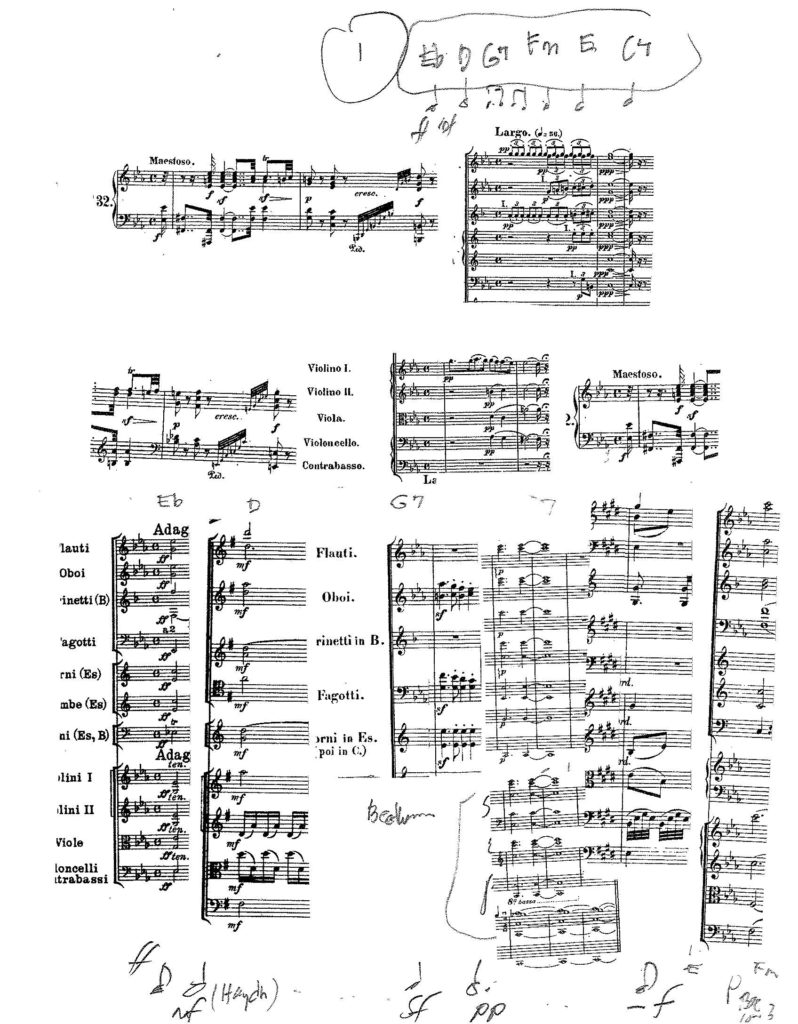 Phantastische Sonate is a collage of fragments from a variety of (mainly) orchestral works, responding to and commenting on the first movement of Beethoven’s last piano sonata, Op. 111, in C minor. The musical quotations come from, among other works, Beethoven’s Piano Concerto No. 3, Eroica symphony, and Pathétique sonata, Berlioz’s Symphonie fantastique, Stravinsky’s Symphony of Psalms, and Haydn’s Symphony No. 99 (which appeared complete on the same concert at which Phantastische Sonate was premiered). Most of the excerpts share the same three-flat key signature as the sonata, or are rooted in C, and they always resonate with it in harmonic and motivic ways, as if notes emanating from the piano cause the same notes to start vibrating in the orchestra. For example, the dramatic E-flat to F-sharp opening of the sonata is cloaked with hints of a passage from Stravinsky’s Symphony of Psalms in which the same two notes figure prominently. Moments later, after the piano’s arrival on a loud G chord, the winds play the unison G’s that open Berlioz’s Symphonie Fantastique. The sudden jump of a century from 1930 Stravinsky to 1830 Berlioz perhaps also helps us reflect on the universality of Beethoven—the way his music ranges across all time and speaks to us just as profoundly today as when it was first written.
Phantastische Sonate is a collage of fragments from a variety of (mainly) orchestral works, responding to and commenting on the first movement of Beethoven’s last piano sonata, Op. 111, in C minor. The musical quotations come from, among other works, Beethoven’s Piano Concerto No. 3, Eroica symphony, and Pathétique sonata, Berlioz’s Symphonie fantastique, Stravinsky’s Symphony of Psalms, and Haydn’s Symphony No. 99 (which appeared complete on the same concert at which Phantastische Sonate was premiered). Most of the excerpts share the same three-flat key signature as the sonata, or are rooted in C, and they always resonate with it in harmonic and motivic ways, as if notes emanating from the piano cause the same notes to start vibrating in the orchestra. For example, the dramatic E-flat to F-sharp opening of the sonata is cloaked with hints of a passage from Stravinsky’s Symphony of Psalms in which the same two notes figure prominently. Moments later, after the piano’s arrival on a loud G chord, the winds play the unison G’s that open Berlioz’s Symphonie Fantastique. The sudden jump of a century from 1930 Stravinsky to 1830 Berlioz perhaps also helps us reflect on the universality of Beethoven—the way his music ranges across all time and speaks to us just as profoundly today as when it was first written.
Phantastische Sonate was written for the pianist Steven Pane, as part of a year-long project examining Op. 111 from many different angles, in collaboration with colleagues in philosophy, poetry, literary criticism, and sound art. He gave the first performance with the University of Maine at Farmington Community Orchestra, conducted by the composer, in April 2014.